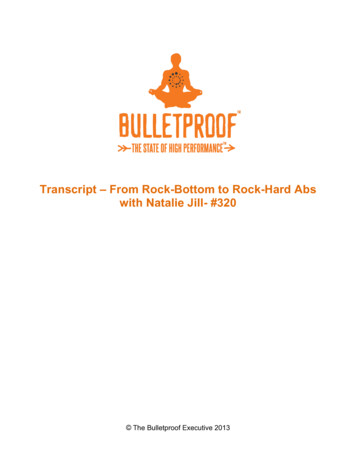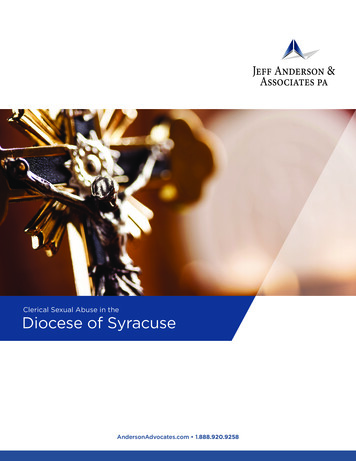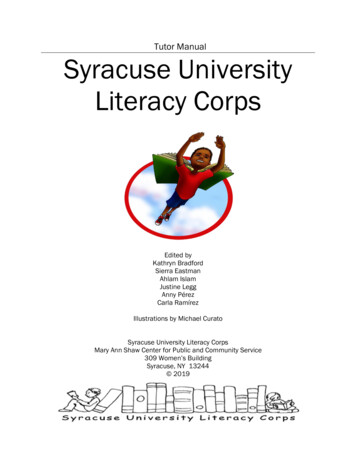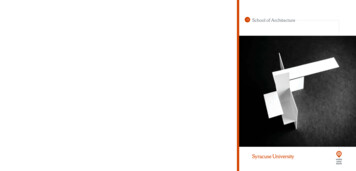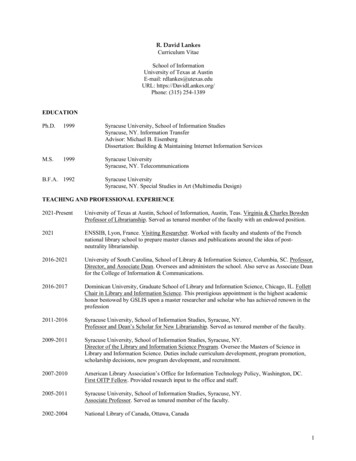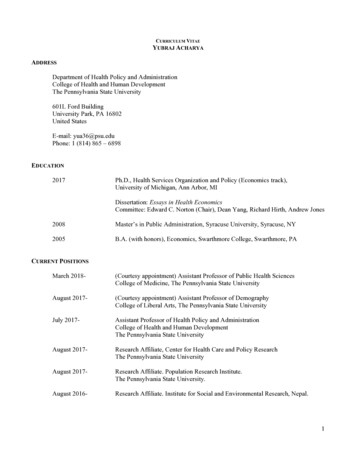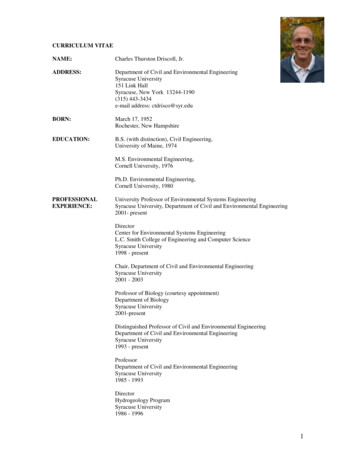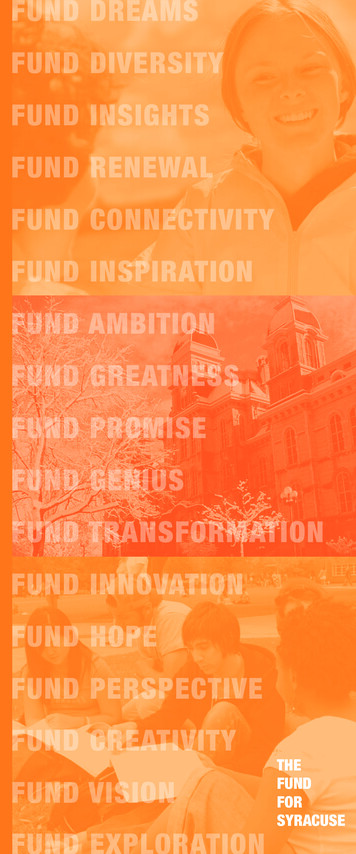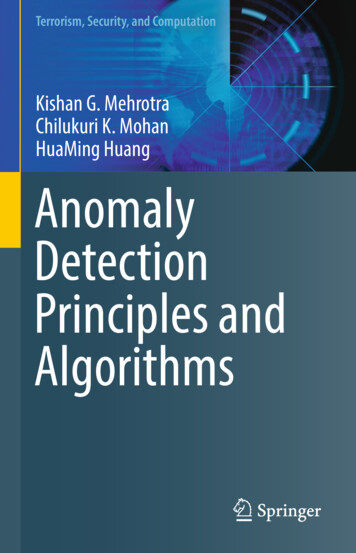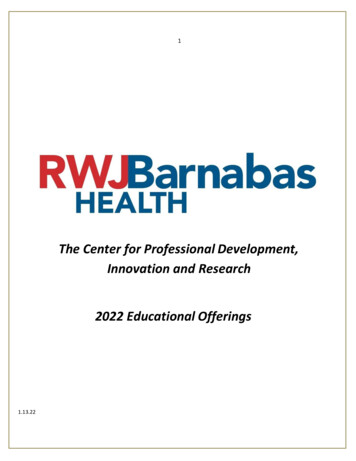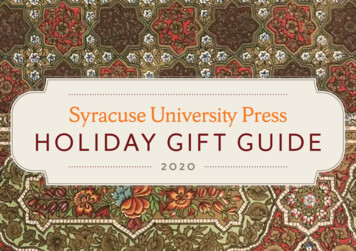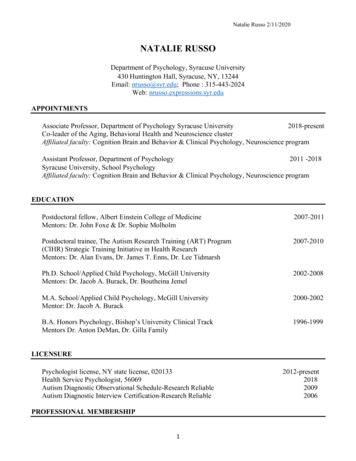
Transcription
Natalie Russo 2/11/2020NATALIE RUSSODepartment of Psychology, Syracuse University430 Huntington Hall, Syracuse, NY, 13244Email: nrusso@syr.edu; Phone : 315-443-2024Web: nrusso.expressions.syr.eduAPPOINTMENTSAssociate Professor, Department of Psychology Syracuse University2018-presentCo-leader of the Aging, Behavioral Health and Neuroscience clusterAffiliated faculty: Cognition Brain and Behavior & Clinical Psychology, Neuroscience programAssistant Professor, Department of Psychology2011 -2018Syracuse University, School PsychologyAffiliated faculty: Cognition Brain and Behavior & Clinical Psychology, Neuroscience programEDUCATIONPostdoctoral fellow, Albert Einstein College of MedicineMentors: Dr. John Foxe & Dr. Sophie Molholm2007-2011Postdoctoral trainee, The Autism Research Training (ART) Program(CIHR) Strategic Training Initiative in Health ResearchMentors: Dr. Alan Evans, Dr. James T. Enns, Dr. Lee Tidmarsh2007-2010Ph.D. School/Applied Child Psychology, McGill UniversityMentors: Dr. Jacob A. Burack, Dr. Boutheina Jemel2002-2008M.A. School/Applied Child Psychology, McGill UniversityMentor: Dr. Jacob A. Burack2000-2002B.A. Honors Psychology, Bishop’s University Clinical TrackMentors Dr. Anton DeMan, Dr. Gilla Family1996-1999LICENSUREPsychologist license, NY state license, 020133Health Service Psychologist, 56069Autism Diagnostic Observational Schedule-Research ReliableAutism Diagnostic Interview Certification-Research ReliablePROFESSIONAL MEMBERSHIP12012-present201820092006
Natalie Russo 2/11/2020American Psychological AssociationInternational Society for Autism ResearchSensory Research ConsortiumHONORS AND AWARDS AND COMPLETED APPOINTMENTSWiSE faculty development award, Syracuse UniversityInterim Director Neuroscience, Syracuse UniversitySeinfeld Fellow, Syracuse UniversityGrant pitch’ program, selected participant: INSARTop 5 autism researchers in QuebecMcGill University, School Psychology Research Fellowship2021Fall 20202020201820042002PROFESSIONAL DEVELOPMENT (2019-present)Non-hierarchical leadership, WiSE programClinic on promotion from Associate to Full Professor, WiSE programMaking the Most of Hot Moments in the Classroom, Syracuse UniversityDeveloping a Nimble and Versatile Workforce, National Academies of Science,Engineering and MedicineRacial Justice, Diversity, Equity and inclusion in neuroscience training.National Academies of Science, Engineering and MedicineSmall Teaching Workshop: The Center for Teaching and Learning Excellence (CTLE)202020202020202020202019RESEARCH INTERESTSSensation, perception and cognition among individuals on the autism spectrum; strength-basedapproaches to assessment; neurophysiology; methodological rigor in the study of intellectual disabilityGRANTSExternal grants under review:The development of inferred perception in ASDType: Binational Science FoundationRole: Investigator (Hadad, Kalish)TDC: 250,000Period: 2021-2025Assessing the primacy and impact of perception in autism spectrum disordersType; National Institute of Mental HealthRole: PITDC: 1, 408,9672
Natalie Russo 2/11/2020Period: 2021-2026Grants in revision:Perception, decision making, Bayesian inference and development (PIs: Russo, Hadad, Kalish, Kellen)Type: National Science Foundation; Binational Science FoundationRole: PITDC: 561,617Period: 2021-2024Developing neuroendophentypes of autism: the power of EEG harnessed by robust machine learning(MPI: Salekin; Russo)Type: NIH R21Role: MPITDC: 275,000Period: 2021-2024External grants active:Developing a sensory model of autism (Project PI: Schaaf; Subproject PIs: Russo, Baranek, Cascio,Woynaroski, Green)Type: Nancy Lurie Marks foundation grantRole: PITDC: SU subcontract 48,970Period: 2019-2022Subcortical and cortical potentials in preterm infants: Towards Development of Biomarkers for autism,hearing loss and language delay (PIs Prieve, Russo).Type: Gerber FoundationRole: PITDC: 8, 428Period: 2018-2020Internal grants activeFollow up of preterm babies to examine age 3- 5 outcomes (PI Prieve, Russo).Type: Collaboration for Unprecedented Success and Excellence (CUSE) GrantRole: Co-PITDC: 28,000Period: 2020-2022Developing signal-processing techniques to identify biomarkers for autism spectrum disordersType: Seed grant program, Syracuse University (PI: Brown, Russo)Role: Co-PITDC: 5,000Period: 2018-2021Completed grants3
Natalie Russo 2/11/2020Measuring Brain Neurophysiology in NeonatesType: Syracuse University small equipment grant (PI: Russo)Role: PITDC: 25,000Period:2019Towards using Auditory subcortical and cortical responses to screen for autism, hearing loss andlanguage disorders (PI: Russo, Beth)Type: Collaboration for Unprecedented Success and Excellence (CUSE) GrantRole: PITDC: 29,380Period: 2018-2020The neurophysiology of sensory processing and multisensory integration among persons with an autismspectrum disorder (PI: Russo)Type: NIMH R01Role: PITDC: 1,435,000Period: 2013-2020 (NCE)The impact of social isolation on cerebrovascular reactivity and cognitive function in communitydwelling older adults (PI: Heffernan, Russo)Type: NIH/NIA P30AG034464Role: Co-ITDC: 31,916Period: 2013-2014Efficacy of whey protein to improve cerebrovascular and cognitive function in older adults.Type: National Dairy Council, Dairy Research Institute (PI Heffernan)Role: Co-PITDC: 349, 617Period: 2012-2015Neurophysiological mechanisms of temporal processing of rapidly presented visual information amongtypically developing children, children with an autism spectrum disorder and children with Velo-CardioFacial Syndrome (PIs: Russo, Kates, Wyble)Type: Hill Environmental medicine collaborationRole: PITDC: 10,000Period: 2012-2014Sensory processing and integration in autism (PI : Molholm & Foxe)Type: NIMH R01Role: Co-ITDC: 2,774,606Period: 2009-20144
Natalie Russo 2/11/2020Multisensory integration in autismType: Postdoctoral Fellowship (FQRSC)Role: PITDC: 40,000Period: 2007-2009Autism Research TrainingType: Postdoctoral FellowshipRole: PITDC: declinedPeriod: 2007-2009Executive function in children with an autism spectrum disorderType: FQRSC Doctoral FellowshipRole: PITDC: 40,000Period: 2003-2006PUBLICATIONS (student co-authors underlined)Under Review1. Levitsky, D., Confair, A.,Wagner, K, DeVita, S., Shea., N., McKernan, E. P., Kopec, J., Russo,N., Middleton, F.A., & Hicks, S. (under review). Longitudinal stability of salivary microRNAbiomarkers in children and adolescents with autism spectrum disorder.2. Russo, N., Kaplan-Kahn, E., Lane, K., Enns, J., & Burack, J.A. (under review). Attentionalprocessing among children with Fetal Alcohol Spectrum Disorders.3. Kaplan-Kahn, E., Russo, N., & Park, A. (under review). ERP evidence for the relationshipbetween ASD traits and enhanced perceptual discrimination.4. Columna, L., Prieto, L., Haibach-Beach, Russo, N., & Folley, J. (under review). A RandomizedFeasibility Trial of a Fundamental Motor Skill Intervention for Children with Autism SpectrumDisorders5. Salekin, A., & Russo, N. (under review). Understanding autism: the power of EEG harnessed byprototypical learning.6. Kaplan-Kahn E. Russo, N., & Kellen, D. (under review). “The volume of your voice does notincrease the validity of your argument,” but a proper dataset might: Spoken language stimulusset with detailed acoustic features.7. McKernan, E. P., & Russo, N. (under review). Factorial Invariance of the CESD-R and DASS21 Across Adults with Low and High Levels of Autistic Traits.5
Natalie Russo 2/11/20208. Helminen, E. C., Kaplan-Kahn, E., Prussien, K. V., Felver, J., & Russo, N. (under review). Ascoping review of transition readiness in adolescents with sickle cell disease: The potential forschool psychologists to fill service gaps.9. Kaplan-Kahn, E., Russo, N., & Iarocci, G. (under review). Validating Three Common SelfReport Measures of Social Functioning: Implications for Autism Research.Peer-reviewed journal articles1. Burack, JA., Evans, D.A., Russo, N., Napoleon, J. S, Goldman, K.J., & Iarocci, G. (in press).Historical and Contemporary Perspectives on Developmental Approaches to the Study ofPersons with Intellectual Disability. Annual Review of Clinical Psychology.2. Burack, J.A., Evans, D.W., Russo, N., Napoleon, J.S., Bus, V., & Iarocci, G. (in press).Science of Humanity and the Humanity of Science: Ed Zigler’s Ongoing Legacy in Making theWorld a Better Place for Children. Development and Psychopathology.3. Russo, N., Kaplan, E., Wilson, J., Criss, A., & Burack, J.A., (in press). Choices, challenges, andconstraints: a pragmatic examination of the limits of mental age matching in empirical research.Development and Psychopathology.4. Kopec J, Hagmann C, Shea N, Prawl A, Batkin D, Russo N. (2020). Examining the TemporalLimits of Enhanced Visual Feature Detection in Children with Autism. Autism Research.2020;10.1002/aur.2361. doi:10.1002/aur.23615. Mac Namara, S. C., Rauh, A.E., Blum, M.M., Russo, N., Green, M.A., & Nangia, S. (2020). PeerMentoring for Women in STEM. American Society for Engineering Education Annual ConferenceProceedings.6. Cary, E. L., Russo, N., Racer, K. H., & Felver, J. C. (2020). Neural Correlate of Acceptance:Relating Individual Differences in Dispositional Acceptance to ErrorProcessing. Mindfulness, 11(6), 1401-1412.7. McKernan, E.P., Cascio, C. & Russo, N. (2020). Sensory overresponsivity as a predictor ofamplitude discrimination performance in youth with ASD. Encyclopedia of Autism SpectrumDisorder.8. Burack, J. A., Evans, D. W., Lai, J., Russo, N., Landry, O., Kovshoff, H., . & Iarocci, G. (2020).Edward Zigler's legacy in the study of persons with intellectual disability: the developmentalapproach and the advent of a more rigorous and compassionate science. Journal of IntellectualDisability Research, 64(1), 1-6.9. Heffernan, K, Columnas, L., Prieto, L, Keller, A, Pagan, P., DeBlois, J., Prawl, A., Revolledo,G., Myers, B, Russo, N., & Barreira, T. (2019). Home blood pressure assessment in childrenwith autism spectrum disorder A feasibility study. Artery Research, 25 (3), 1175-1196.6
Natalie Russo 2/11/202010. Hadad, B., Burack, J.A., Russo, N., & Kimchi, R. (2019). Typical utilization of Gestalt groupingcues in shape perception in ASD.11. McKernan, E. P., Wu, Y., & Russo, N. (2019) Sensory overresponsivity as a predictor ofamplitude discrimination performance in youth with ASD. Journal of Autism and DevelopmentalDisorders,1-9, https://doi.org/10.1007/s10803-019-04013-012. Anthsel, K., & Russo, N. (2019). Autism Spectrum Disorders and ADHD - OverlappingPhenomenology, Diagnostic Issues and Treatment Considerations. Current Psychiatry Reports,21 (5), 3413. Kopec, J., Russo, N., Antshel, K., Freemont, W., & Kates, W. (2018). Temporal attentionalprocessing among persons with 22q11.2 syndrome. Cortex, 108, 67-7914. Russo, N., Hagmann, C., Andrews, R., Black, C. Silberman, M., & Shea, N. (2018). Validationof the C.A.R.E. stim set of 650 animal pictures: name agreement and quality ratings. PLOS One,13, 2, https://doi.org/10.1371/journal.pone.019290615. Shea, N., Payne, E., & Russo, N. (2018) Predictors of externalizing behaviors in AutismSpectrum Disorders. Journal of Autism and Developmental Disorders, 58, (6), 2237-2242.16. Russo, N., LeBlanc, M., Shea, N. , Kates, W. R., & Wyble, B. (2018). Adults blink more deeply:A comparative study of the attentional blink across different age groups. Developmental Science,21 (2), e1251217. Shea, N., Kopek, J. , McKearnen, E. , & Russo, N. (2018). Autism Rating scales. The SAGEEncyclopedia of Intellectual and Developmental Disorders.18. Heffernen, K., Columna, L., Russo, N., Myers, B., Ashby, C.E., Norris, M.L., & Barreira, T.V.(2018). Physical activity, body mass index and central hemodynamic burden in children with anAutism Spectrum Disorder: Preliminary findings. Journal of Autism Spectrum Disorders, 48(2),625-631.19. McKernen, E. P., Russo, N. Burnette, C., & Kates, W. (2017). ASD concordance of twins acrossDSM-IV-TR and DSM-5 diagnostic criteria. Research in Autism Spectrum Disorders, 41, 51-56.20. Russo, N., Kates, W., & Wyble, B. (2017). The development of the attentional blink in a featurebinding task: errors and correct responses tell different parts of the story. Journal ofExperimental Child Psychology, 164-32-44.21. Davis, T.D., Columna, L., Abdo, A.L., Russo, N., Toole, K., & Norris, M.L. (2017). Usingsensory motor activities and training for families of children with Autism Spectrum Disorders.Palaestra.22. Hadad, B.S., Goldstein, E. K., & Russo, N. (2017). Atypical perception in autism: A failure ofperceptual specialization? Autism Research. [Epub ahead of print]7
Natalie Russo 2/11/202023. Campbell, A., Russo, N, Landry, O., Jankowska, A. M., Stubbert E., Jacques, S. & Burack, J.A.(2017). Nonverbal, rather than verbal, functioning may predict cognitive flexibility amongpersons with autism spectrum disorder: A preliminary study. Research in Autism SpectrumDisorders 38, 19-25.24. Burack, J. A., Russo, N., Kovshoff, H., Palma Fernandes, T., Ringo, J., Landry, O., & Iarocci, G.(2016). How I attend—not how well do I attend: Rethinking developmental frameworks ofattention and cognition in autism spectrum disorder and typical development. Journal ofCognition and Development, 17(4), 553-567.25. Hagmann, C.E., & Russo, N. (2016). Multisensory integration of redundant trisensorystimulation. Attention, Perception and Psychophysics, DOI: 10.3758/s13414-016-1192-626. Hagmann, C. E, LeBlanc, M., Kates, W., Wyble, B., & Russo, N. (2016). Children with Autismdetect targets at very rapid presentation rates with similar accuracy as adults. Journal of Autismand Developmental Disorders, 46(5), 1762-72.27. Foxe, J. J., Molholm, S., Del Bene, Victor A., Russo, N., Blanco, D., Frey, H.P., Saint-Amour,D., & Ross, L., (2015). Severe multisensory speech integration deficits in high-functioning schoolaged children with an autism spectrum disorder and their resolution during early adolescence.Cerebral Cortex, 25(2), 298-312.28. Kates, W. R., Russo, N., Wood, W. M., Antshel, K. M., Faraone, S. V., & Fremont, W. P.(2015). Neurocognitive and familial moderators of psychiatric risk in velocardiofacial (22q11. 2deletion) syndrome: a longitudinal study. Psychological medicine, 45(8), 1629-39.29. Lane, K., Stewart, J., Fernandes, T., Porporino, M., Russo, N., Enns, J. T., & Burack, J. A.,(2014). Complexities in understanding attentional functioning among children with FetalAlcohol Spectrum Disorder. Frontiers in Human Neuroscience, 8.30. Berko, E. R., Suzuki, M., Beren, F., Alaimo, C., Calder, R. B., Ballaban-Gil, K. et al. (2014).Mosaic epigenetic dysregulation of ectodermal cells in autism spectrum disorder. PLoS genetics,10(5), e1004402.31. Frey, H. P., Molholm, S., Lalor, E., Russo, N., & Foxe, J.J. (2013) Atypical corticalrepresentation of peripheral visual space in children with an autism spectrum disorder. EuropeanJournal of Neuroscience, 38, 2125-38.32. Brandwein, A., Foxe, J. J., Butler, J., Russo, N., & Altschuler, T., & Molholm, S. (2013). Thedevelopment of multisensory integration in high functioning autism: High-density electricalmapping and psychophysical measures reveal impairments in the processing of audiovisualinputs. Cerebral Cortex, 23, 1329-41.33. Campbell, C., Landry, O., Russo, N., Jacques, S., Flores, H., & Burack, J.A. (2013). Cognitiveflexibility among individuals with Down Syndrome: Assessing the influence of verbal and non-8
Natalie Russo 2/11/2020verbal abilities. American Journal on Intellectual and Developmental Disabilities, 118(3), 193200.34. Landry, O., Russo, N., Dawkins, T., Zelazo, P.D., & Burack, J. A. (2013). The Impact of Verbaland Nonverbal Development on Executive Function in Down Syndrome and WilliamsSyndrome. Journal on Developmental Disabilities and the International Journal of DownSyndrome, Joint Issue, 18(2), 26-35.35. Fryberg, S., Troop-Gordon, W., D’Arrisso, A., Flores, H., Ponizovsky, V., Ranney, J., Mandour,T., Tootoosis, C., Robinson, S., Russo, N., & Burack, J. A. (2013). Cultural mismatch and theeducation of aboriginal youth: The interplay of cultural identities and teacher ratings.Development and Psychology, 49(1), 72.36. Burack, J. A., Dawkins, T., Stewart, J., Flores, H., Iarocci, G., & Russo, N. (2012). "Themysterious myth of attention deficit" revisited: A discussion of how the developmental approach istransforming the understanding of intellectual disability. International Review of Research inDevelopmental Disabilities, 42, 147-77.37. Russo, N., Burack, J. A., Mottron, L., & Jemel, B. (2012) Parameters of semantic multisensoryintegration depend on timing and modality order among people on the autism spectrum: Evidencefrom event-related potentials. Neuropsychologia, 50, 2131-41.38. Altschuler, T. S. Molholm, S., Russo, N, Snyder, A.C., Brandwein, A. B., Blanco, D., & Foxe, J.J. (2012). Early electrophysiological indices of illusory contour processing within the lateraloccipital complex are virtually impervious to large-scale manipulations of illusion strength.NeuroImage, 59(4), 4074-85.39. Brandwein, A. B., Foxe, J. J. F, Russo, N., Altschuler, T. Gomes, H., & Molholm, S. (2011). Thedevelopment of audiovisual multisensory integration across childhood and early adolescence: Ahigh-density electrical mapping study. Cerebral Cortex, 21(5), 1042-55.40. Russo, N., Foxe, J. J., Gomes, H., Brown, A., Altschuler, T, Gomes, H., & Molholm, S. (2010).Multisensory Processing in Children with Autism: High-density electrical mapping of auditorysomatosensory integration. Autism Research, 3, 1-15.41. Stewart, M. E., Russo, N., Banks, J., Miller, L., & Burack, J. A. (2009). Sensory Characteristicsin ASD. McGill Journal of Medicine, 12, 108-111.42. Burack, J.A., Joseph, S., Russo, N., Shore, D., Porporino, M., Enns, J. (2009). Change detectionin naturalistic pictures among children with autism. Journal of Autism and DevelopmentalDisorders, 39(3), 471-79.43. Flanagan, T., Russo, N., Flores, H., & Burack, J. A. (2008). The developmental approach to thestudy of Down syndrome: Contemporary issues in historical perspective. Down SyndromeResearch and Practice, 96-100.9
Natalie Russo 2/11/202044. Burack, J. A. & Russo, N. (2008). On why joint attention might look atypical in autism: A casefor a strong policy statement but more nuanced empirical story. Child Development Perspectives,2(1), 46-48.45. Russo, N., Burack, J., Flanagan, T., Berringer, D., Iarocci, G. & Zelazo, P. D. (2007).Deconstructing executive deficits among children with autism: implications for cognitiveneuroscience. Brain and Cognition, Special Issue, 77-86.46. Flanagan, T., Enns, J., Russo, N., Randolph, B., Abedutto, L., Murphy, M., & Burack, J. A.(2007). Differences in visual orienting between persons with Down or Fragile syndromes. Brainand Cognition, Special Issue, 128-34.47. Burack, J. A., Russo, N., Matejka-Grivas, A., Bonnel, A., & Iarocci, G. (2005). Science inmotion: The quest for coherence in emerging research on autism. Current Psychology ofCognition, 23, 84-93.48. Cornish, K., Burack, J., Rahman, A., Russo, N., & Grant, C. (2004). Theory of mind deficits inchildren with fragile X syndrome. Journal of Intellectual Disability Research, 492, 372-78.Book chapters1. Kaplan, E., McKernan, E., Kopec, J., & Russo, N. (under review). The development of attention inDown Syndrome. In J.A. Burack & J. Edgin (Eds.) The Oxford Handbook of Down Syndrome andDevelopment. Oxford University Press.2. Russo, N., Luke, M., Columna, L., Heffernan, K., & Ingram, E. (2017). A community-basedtheatre arts program for adults with disabilities: finding evidence through research, observation,and individual transformation. In M. Reason, N. Rowe (Eds.), Applied Practice: Evidence andImpact in Theatre, Music and Art. Bloomsbury Methuen: London3. Burack, J.A., Reynolds, A., Landry, O., Klassen, G., Russo, N., & Fryberg, S. (2017). CulturalPerspectives and Influences on Developmental Psychopathology: Lessons about Risk, Disorderand Well-being from the Study of the Indigenous Peoples of North America. Handbook on culturalinfluences. Wiley.4. Burack, J.A., Russo, N., Gordon-Green, C. Landry, O & Iarocci, G. (2016). Developments in theDevelopmental Approach to Intellectual Disability. In D. Ciccetti (Ed.). DevelopmentalPsychopathology, 1-67. Wiley.5. Eckert, T., Hier. B. O., & Russo, N. (2013). Best Practices in School Psychologists’ Promotion ofEffective Collaboration and Communication between School Professionals. In Patti L. Harrisonand Alex Thomas (Eds). Best Practices in School Psychology: Data-Based and CollaborativeDecision Making, 541-53. NASP: Bethesda, MD.6. Burack, J. A., Russo, N., Flores, H., Iarocci, G., & Zigler, E. (2012). The more we know, the lesswe know, but that’s OK: Developmental implications for theory, methodology, and10
Natalie Russo 2/11/2020interpretation. In J. A. Burack, R. M. Hodapp, G. Iarocci, & E. Zigler (Eds.), Handbook ofintellectual disability and development, 3-10. New York: Oxford University Press.7. Russo, N., Dawkins, T., Huizinga, M., & Burack, J. A. (2012). Executive functions andintellectual disability: A developmental perspective. In J. A. Burack, R. M. Hodapp, G. Iarocci,& E. Zigler (Eds.), Handbook of intellectual disability and development, (pp. 125-137). NewYork: Oxford University Press.8. Burack, J. A., Russo, N., Dawkins, T., & Huizinga, M (2010). Development and regressions inrule use: The case of Zenadine Zidane. In B. W. Sokol, J. Carpdendale, U Müller, A. Young, A.,& G. Iarocci (Eds.). Self- and social-regulation: Exploring the relations between socialinteraction, social cognition, and the development of executive functions (pp. 111-128). NewYork: Oxford University Press.Manuscripts in progress (students co-author underline)1. Cary, E., Prieve, B., Pacheco, D., Garber, M., & Russo, N. (in prep). Enhanced perception inautism spectrum disorders: evidence for early neurophysiological differences in habituation anddiscrimination.2. Kaplan-Kahn, E., Russo, N., Shea, N., Prawl, A., Kates, W., & Wyble, B. (in prep). Detectingcolor targets in autism using RSVP: brain, behavior, symptom correlates.3. Russo, N., Hagmann, C., Prawl, A., Kates,W., & Wyble, B. (in prep). Encoding latencyadvantages do not translate into higher accuracy: evidence from single and dual target RSVPtasks and electrophysiology.4. Matsuba, E., Russo, N., McKernan, E. P., Miseros, M., Curl, R., & Burack, J.A. (in prep).Attentional processing in DS.5. Russo, N., Cascio, C., Baranek, G., Woynaroski, T., Williams, Z., Green, S., and the autismsensory research consortium (in prep). A developmental sensory model of autism.PRESENTATIONSConference or symposium presentations:1. Russo, N. (June, 2020). Changing perceptions of autism spectrum disorders through(neuro)science. Grand Rounds at SUNY Upstate medical school, department of psychiatry.2. Russo, N. (April 6th, 2018). Changing perceptions of autism spectrum disorders through(neuro)science. Invited talk at the Syracuse University Neuroscience Research day11
Natalie Russo 2/11/20203. Russo, N. (invited, June 16th, 2017). Sensory processing and multisensory integration in autismspectrum disorders. Invited conference presenter and discussant. Symposium on Vision andOther Sensory Functions in Autism. Thomas Jefferson University4. Columna, L., Dillon, S., Norris, M., Russo, N., Myers, B., Ashby, C., Barreira, T., Heffernan, K.(Fall, 2016). The Role of Interdisciplinary Interventions for Children with Disabilities: PhysicalActivity Programs for Children with Autism. Presented at the National Federation of AdaptedPhysical Activity held in Canada.5. Russo, N. (March 30th, 2016). Symposium presentation: Advances in neurodevelopmental theoryand implications for research approaches in neurodevelopmental disorders. The ART programand NeuroDevNet invitation to the Autism Research Training Winter Institute, Banff, Alberta,Canada6. Russo, N. (May, 14, 2015). Visual Search in Time Among Persons with an Autism SpectrumDisorder. Part of a panel on “Attending to Attention Among Persons with Autism SpectrumDisorder: Perspectives on Strengths, Weaknesses, and Goodness-of-Fit”. International Meetingfor Autism Research, Salt Lake City, Utah.7. Russo, N. (December 4th, 2014). Visual attention in typical development, autism spectrumdisorder and velo-cardio-facial syndrome. Grand Rounds. SUNY Upstate8. Russo, N., Burack, J.A., Hosein, A. & Jemel., B., (May, 2008). Barking Frogs and ChirpingFrogs: A behavioral and brain EEG study of multisensory matching among persons with AutismSpectrum Disorders, International Meeting for Autism Research. London, England.9. Russo, N. (June, 2012). Autism Spectrum Disorders: A clinical and research perspective. Projectadvance lecture. Syracuse, NY.Guest lectures in academic settings:1. Russo, N. (November 9, 2018). Autism Spectrum Disorders: the sensory perspective. Guestlecture for Dr. Louise Manfredi. Industrial Design course. The Warehouse, Syracuse, NY.2. Russo, N. (October 10, 2018). Event-related potentials: methods and measurement. Invitedlecture Methods in Neuroscience, Syracuse University.3. Russo, N. (March 22, 2018). Developmental psychopathology and neuroscience: perspectivesfrom intellectual disability research. Invited lecture at McGill University4. Russo, N. (November 2nd, 2017). Autism Spectrum Disorders: the sensory perspective. Guestlecture for Dr. Louise Manfredi. Industrial Design course. The Warehouse, Syracuse, NY.5. Russo, N. (April 7th, 2017). Opening address, Neuroscience Research Day, Syracuse, NY.12
Natalie Russo 2/11/20206. Russo, N. (March 9th, 2017). Sensory processing and multisensory integration in AutismSpectrum Disorders. Seminar given to students in Graduate Neuroscience Concentration,Syracuse University7. Russo, N. (February 23rd, 2017). The reciprocal relationship between development andneuroscience. Invited lecture at McGill University8. Russo, N. (April 1st, 2016). Meet the expert lunch: perception and sensation in autism spectrumdisorders. The ART program and NeuroDevNet invitation to the Autism Research TrainingWinter Institute, Banff, Alberta, Canada.9. Russo, N. (March 30th, 2016). 10 tips for surviving the transition to the tenure track: tips forsetting up and managing a lab. The ART program and NeuroDevNet invitation to the AutismResearch Training Winter Institute, Banff, Alberta, Canada.10. Russo, N. (April 15, 2016). Opening address, Neuroscience Research Day, Drumlins, Syracuse,NY.11. Russo, N. (December 4, 2015). The Peer Review Process. Colloquium for the Cognition, Brainand Behavior proseminar series.12. Russo, N. (November 13, 2015). Sensory processing and multisensory integration in AutismSpectrum Disorders. Seminar given to students in Graduate Neuroscience Concentration,Syracuse University13. Russo, N. (November 10, 2015). A primer on Event-Related Potentials. Seminar given tostudents in Graduate Neuroscience Concentration, Syracuse University14. Russo, N. (November 16th, 2014). Sensory processing and multisensory integration amongindividuals with an autism spectrum disorder. NIH BRAINS Award ceremony, Washington,D.C. Society for Neuroscience.15. Russo, N. (November 1, 2013). Multisensory integration in ASD. Talk given to the Dean’sTeam, Syracuse University, November 1.16. Russo, N. (December 4th, 2012). Guest lecture: New set of diagnostic criteria for autism:Potential impacts on service eligibility and family services. Syracuse University NeuroscienceCapstone class17. Russo, N. (November, 29th, 2012). Guest lecture: Autism: A variant within the human species?Syracuse University Neuroscience Capstone class.Community outreach/workshops1. Russo, N. (August 19-20th, 2019). Autism in the schools. Seminar given to Lafayette Schooldistrict 8. Russo, N. (October, 26, 2019). So, you want to be a school psychologist ? Talk given13
Natalie Russo 2/11/2020to students interested in school psychology, Diversifying Psychology weekend, SyracuseUniversity.2. Russo, N. (October, 26, 2018). So, you want to be a school psychologist ? Talk given tostudents interested in school psychology, Diversifying Psychology weekend, SyracuseUniversity.3. Russo, N. (November 10, 2013). Developing a partnership between the SU community and theCARE lab. Talk given to parents of children with an ASD. November 10, Syracuse University.4. Russo, N. (December, 2009). Multisensory integration among persons with ASD: Evidence fromelectrophysiology. Invited address for the Autism Parent Society of NY, Nyack.5. Russo, N. (December, 2009). Reframing behavioral management in ASD using the TEACCHapproach. Invited address for the Autism Parent Society of NY, Nyack.6. Russo, N., Brown-Brandwein, A., & Molholm, S. (October, 2008). Introduction to multisensoryresearch: a primer for parents. Invited address for the Autism Parent Society of NY, Nyack.7. Russo, N. (January, 2007). Miriam foundation Community Outreach Program: Visual Strategiesfor persons with developmental disabilities, Montreal, Qc, 60 minutes8. Russo, N. (February, 2007). Miriam Foundation Lecture Series: Introduction to the TEACCHmodel: Philosophy and approaches to treatment for Autism Spectrum Disorders. Montreal, QCOtherRusso, N.R. (2018). Psychological (Neuro)science in the service of autism. Seinfeld ScholarPresentation. Syracuse University.Posters Presentations (since 2009)1. Cary, E.L., Kaplan-Kahn, E.A., Masters, E.C, Matsuba, E., MacKenzie, C., Rodrigues, A.,Prieve, B., Pacheco, D., Madrid, A., & Russo, N. (submitted). Relating ASD Traits and SensoryOverresponsivity to Early Electrophysiological Indices of Auditory Processing in Children withand without ASD. International Society for Autism Research 2021 Annual Meeting2. Masters, E.C., McKernan, E.P., Kopec, J., Kaplan-Kahn, E.A., Cary, E.L., Matsuba, E.,Rodrigues, A., MacKenzie, C., & Russo, N. (submitted). The Impact of ADHD Symptoms andAge on Sensory Features in Autism. International Society for Autism Rese
Mentors Dr. Anton DeMan, Dr. Gilla Family LICENSURE . Ed Zigler's Ongoing Legacy in Making the World a Better Place for Children. Development and Psychopathology. . B., Ashby, C.E., Norris, M.L., & Barreira, T.V. (2018). Physical activity, body mass index and central hemodynamic burden in children with an Autism Spectrum Disorder .
